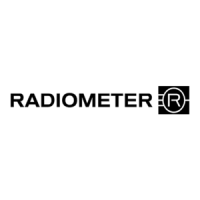ABL90 FLEX reference manual 5. Sensors and optical system
5-3
General measuring principles
There are four different measuring principles employed in the sensors in the
ABL90 FLEX analyzer.
Potentiometry: The potential of a sensor chain is recorded using a
voltmeter, and related to the concentration of the sample (the Nernst
equation). The potentiometric measuring principle is applied in the pH, pCO
2
,
K
+
, Na
+
, Ca
2+
and Cl
—
sensors.
Amperometry: The magnitude of an electrical current flowing through a
sensor chain is proportional to the concentration of the substance being
oxidized or reduced at an electrode in the chain. The Amperometric measuring
principle is applied in the cGlu and cLac sensors.
Optical pO
2
: The optical system for pO
2
is based on the ability of O
2
to
reduce the intensity and time constant of the phosphorescence from a
phosphorescent dye that is in contact with the sample. This measuring
principle is applied in the pO
2
sensor.
Spectrophotometry: Light passes through a cuvette containing a hemolyzed
blood sample. The specific wavelengths absorbed and their intensity
generates an absorption spectrum used to calculate oximetry parameters.
This measuring principle is used for measuring ctHb, sO
2
, FO
2
Hb, FCOHb,
FHHb, FMetHb, FHbF and ctBil.
The first three measuring principles are described under the sensors, where they
are applied. Spectrophotometry is described in the section titled ctHb and
derivates.
Strictly speaking, in potentiometry the potential of a sensor chain is related to
the activity of a substance, and not its concentration.
The activity of a substance can be considered the "effective concentration" of a
species, taking non-ideality of the medium into account.
Activity and concentration are related by the following equation:
a
x
= c
x
where:
a
x
=
the activity of the species x
=
the activity coefficient of species x under the measurement conditions
(for ideal systems = 1)
c
x
=
the concentration of species x (mol/L)
NOTICE: To be exact, activity is related to the molality of species x, i.e. the
number of mol/kg of solvent. However molality is converted to concentration
(molarity).
The analyzer automatically converts activities into concentrations. The term
concentration is therefore used in explanations of the measuring principles for
each of the sensors further on in this chapter.
Introduction
Activity vs.
concentration
Conversion of
activity to
concentration

